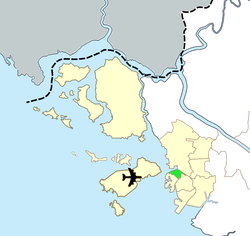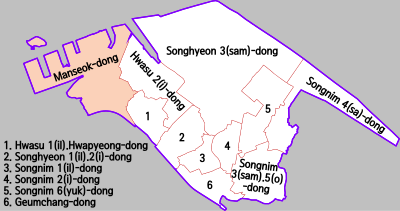
Incheon, formerly Jemulpo or Chemulp'o (제물포) until the period after 1910, officially the Incheon Metropolitan City, is a city located in northwestern South Korea, bordering Seoul and Gyeonggi to the east. Inhabited since the Neolithic, Incheon was home to just 4,700 people when it became an international port in 1883. Today, about 3 million people live in the city, making it South Korea's third-most-populous city after Seoul and Busan.

Tseung Kwan O New Town is one of the nine new towns in Hong Kong, built mainly on reclaimed land in the northern half of Junk Bay in southeastern New Territories, after which it is named. The town/land area is usually known simply as Tseung Kwan O.
South Korea is made up of 17 first-tier administrative divisions: 6 metropolitan cities, 1 special city, 1 special self-governing city, and 9 provinces, including one special self-governing province. These are further subdivided into a variety of smaller entities, including cities, counties, districts, towns, townships, neighborhoods and villages.

Bucheon is a city in Gyeonggi Province, South Korea. Bucheon is located 25 kilometers (16 mi) away from Seoul, of which it is a satellite city. It is located between Incheon and Seoul.

Gwangmyeong is a city in Gyeonggi Province, South Korea. It borders Seoul to the east, north and northeast, Anyang to the southeast, Siheung to the southwest, and Bucheon to the northeast.

Haeundae District is a district (gu) of Busan, South Korea.

Yeongdeungpo District is an administrative district in southwest Seoul, South Korea. Although the origin of the name is uncertain, the first two syllables are thought to be from "yeongdeung" (靈登) or "divine ascent", a shamanic rite. The third syllable is "po", representing the bank of a river (浦), referring to the district's position on the Han River. The 2006 population was 408,819.

Yeongjong Island is an island off the west coast of the city of Incheon, South Korea, which contains Incheon International Airport as well as small villages, farms, and beaches. The previously separate Yongyu, Sammok, and Sinbul Islands have been joined to Yeongjong Island by an area of reclaimed land built for the construction of the airport. The island is an exclave of Incheon Metropolitan City's Jung-gu district, and is accessed via two bridges, Yeongjong Bridge connecting to Seo-gu and Incheon Bridge connecting to Songdo.
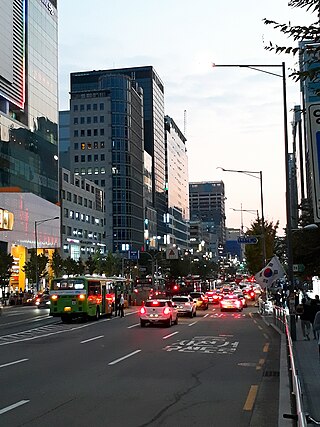
Mapo District is one of the 25 districts of Seoul, South Korea.

Jung District (Jung-gu) is a gu, or district, covering the downtown area of Daegu, South Korea. It borders most of the other districts of Daegu, including Nam-gu to the south, Seo-gu to the west, Buk-gu to the north, and Dong-gu and Suseong-gu to the east. The northern border is formed by the Gyeongbu Line railroad, and the eastern border by the Sincheon stream.

Guro District (Guro-gu) is a district of Seoul, South Korea, which was separated from Yeongdeungpo District on April 1, 1980. Located in the southwestern part of the city, where besides Yangcheon District and Geumcheon District Guro District has an important position as a transport link which contains railroads, land routes from the rest of Seoul to the south of the country. The Gyeongbu and Gyeongin railway lines connect Seoul to Busan and Incheon. In addition, Seoul Metropolitan Subway lines 1, 2, and 7, and major highways intersect in Guro District.
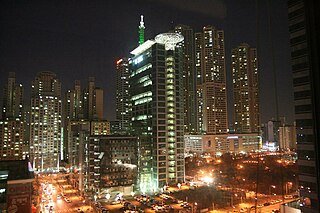
The Yangcheon District (Yangcheon-gu) is a gu, or district, of Seoul, South Korea, located on the southwest side of the Han River. At the centre of this district is the Mok-dong area, which is home to numerous shopping outlets, bars and restaurants, an ice rink, and large residential buildings inhabited by mostly upper-middle and upper-class families.

Bupyeong District (Bupyeong-gu) is one of the 10 administrative divisions that comprise Incheon, South Korea. Bupyeong-gu comprises an area of 12.35 square miles, and has a population of 508,587. It is located north of Namdong-gu, east of Seo-gu, and south of Gyeyang-gu. The city of Bucheon, in neighboring Gyeonggi Province, comprises its eastern limit.

Jung District is the historic central ward of the city of Incheon, South Korea, one of the eight wards into which Incheon is divided. Its name means "central" in Korean. It was founded in 1883 on the opening of the Jemulpo Port and contains several historical and cultural heritage monuments, such as Dap-dong Cathedral, Hongyemun Gate, The First Anglican Church, and Jayu Park, Korea's first modern park.
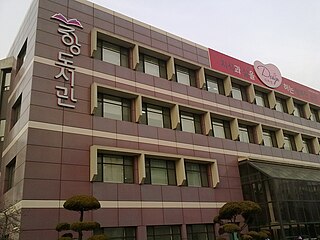
Namdong District (Namdong-gu) is a municipal district in Incheon, South Korea. Namdong-gu has been the city centre of Incheon since 1985. It is the location for Incheon Metropolitan City Hall, Incheon Metropolitan Police Agency main offices, the Namdong Industrial Complex, and Gil Hospital & Gachon Medical School. There is a large shopping district close to the City Hall and Grand Theater containing 3 large department stores, many restaurants and bars and the 2.68 km (1.67 mi) long Jung-Ang city park.
Hadang (Korean: 하당신도시) is the newly built urban area in Mokpo, Jeollanam-do of South Korea, which aims at accommodating increased population near Muan International Airport and movement of the provincial office. Before announcement of the transfer of office, Mokpo city initially intended to rebuild another area for housing. The project was finalized so until 1999 most of area was leased for marketing, business, housing, and preliminary purpose.

The Seoul Capital Area (SCA), Sudogwon or Gyeonggi region, is the metropolitan area of Seoul, Incheon, and Gyeonggi Province, located in north-west South Korea. Its population of 26 million is ranked as the fourth largest metropolitan area in the world. Its area is about 12,685 km2 (4,898 sq mi). It forms the cultural, commercial, financial, industrial, and residential center of South Korea. The largest city is Seoul, with a population of approximately 10 million people, followed by Incheon, with 3 million inhabitants.
Yeongjong-Yongyu(영종용유, 永宗龍游) is a region in Jung District, Incheon. It encompass Yeongjongdo and adjacent islands such as Muuido except Bukdo-myeon, Ongjin County, Incheon. The island is an exclave of Incheon Metropolitan City's Jung-gu district, It is accessed via two bridges, Yeongjong Bridge connecting to Seo-gu and Incheon Bridge connecting to Songdo. Many residents Yeongjong-Yongyu demanded that Yeongjong-Yongyu should be a district of Incheon and old downtown area of Jung District, Incheon should be merged with Dong District, Incheon. In 2022, Yeongjong-Yongyu's Korean national population exceeded 100 thousands and old downtown area of Jung and Dong Districts.
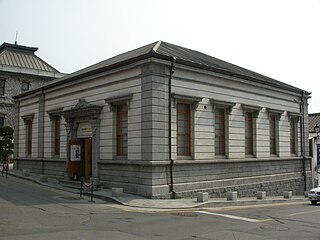
Jemulpo District is a proposed ward of the city of Incheon, South Korea, Jemulpo-gu is located in a historic center of Incheon. Jemulpo was founded in 1883 on the opening of the Jemulpo Port and contains several historical and cultural heritage monuments, such as Dap-dong Cathedral, Hongyemun Gate, The First Anglican Church, and Jayu Park, Korea's first modern park.
Songwol-dong Fairy Tale Village, or Songwol-dong Donghwa Village, is a fairy tale-themed village located in Songwol-dong, Jung-gu, Incheon.

